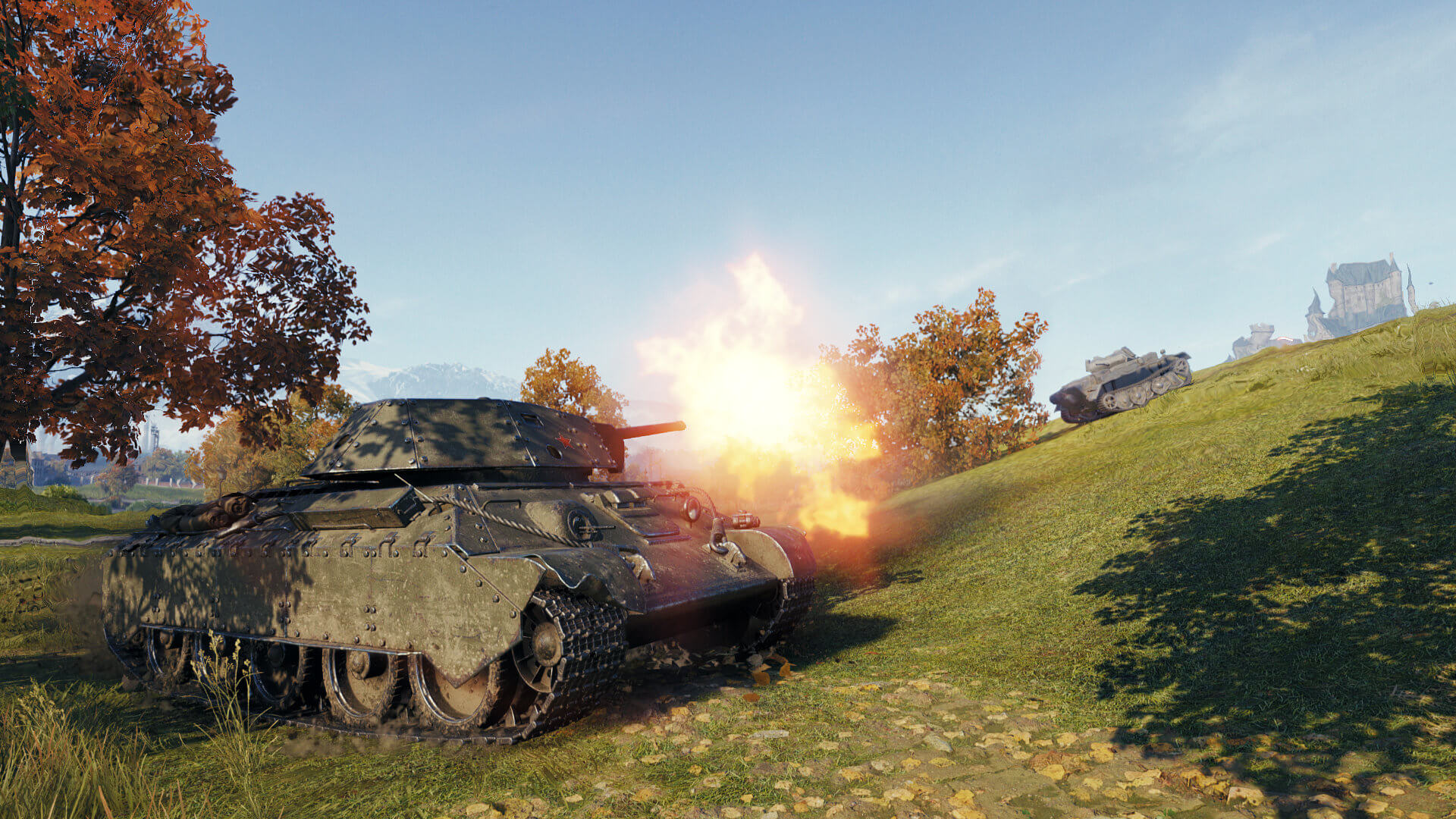DEFINITION | FUNCTION | DEPLOYMENT | TRY SPACED ARMOR IN-GAME TODAY
Commanders!
You've probably seen the additional plates mounted on a number of in-game vehicles. But have you ever wondered what they're for? Well, to answer your question, this is what's known as "spaced armor." Essentially, it's extra protective armor that reduces the impact of incoming projectiles, while saving on weight and cost.
So, where did it come from, how effective is it, and where is it used? With the
 VII
VII
IS-2 shielded
currently on offer in the Premium Shop, we thought this would be the perfect time to take a closer look at spaced armor. Read on tank enthusiasts!
Definition
"Spaced armor" refers to two or more armor plates spaced slightly apart, and representing approximately 10% of the total armor weight. The thinner plate, often made of steel or rubber, is usually welded or bolted onto the side of the vehicle—typically around the tracks, front, or sides of the tank, or where the ammunition is stored—to best protect the most vulnerable sections.
 Excelsior
Excelsior  IS-2 shielded
IS-2 shielded
Left: The Excelsior (in-game) Right: The IS-2 shielded (in-game)
Function
Reducing Penetrating Power
The aim of the thin plate is to essentially absorb the major impact of a projectile some distance from the main armor, preventing the full force of the detonation from breaching the main armor. The hollow space between the plates increases the shell's travel time, thus reducing the charge's penetrating power. Even 2 inches (5 cm) of spaced armor is enough to dampen the effectiveness of a projectile.
Sloping
When sloped, the additional armor reduces the full force of anti-tank rounds and shells by deflecting or splintering the round. Conversely, when the armor is not sloped, it increases protection, because explosive projectiles detonate on the spaced armor before they reach the main armor. The most effective angle is approximately between 60-65°, or 300° when dealing with AP (Armor Piercing) shells.
"Placing a 1/2" (2.5–5 cm) thick plate in front of the 6" (15 cm) thick armor reduced the range at which the target could be defeated from 2,900 yards (2,650 meters) to 350 yards (320 meters)!"
- Spaced Armor Paper Presented at the Second Tank Conference Ballistic Research Laboratories, Aberdeen Proving Ground, Maryland, 27-29 November 1950
Cost and Weight Savings
Spaced armor is most efficient when the most exposed plate breaks up the attacking projectile. Spaced armor arrangements can save between 10–50% in cost and weight over solid armor, with little compromise in overall protection. This figure fluctuates depending on the angling, type of penetration, and other various factors.
 M48A2 Räumpanzer
M48A2 Räumpanzer  T-34 shielded
T-34 shielded
Left: The M48A2 Räumpanzer (in-game) Right: The T-34 shielded (in-game)
Deployment
Germans Ahead of the Curve
The Germans first used spaced armor in World War I on the Schneider CA1 and Saint-Chamond tanks. However, spaced armor became increasingly common in the Second World War, as Germans began to frequently fit it on tanks, assault vehicles, and motorized artillery mounts with thin plates suspended by brackets along the hull and turret sides. This made the armor more effective against anti-tank fire amid the onslaught of Allied anti-tank rifles, APCR (Armor Piercing Composite Rigid) shells, and HEAT (High Explosive Anti Tank) weapons.
"The Armored and Mechanized Forces HQ notice from January 25, 1944, stated the wire-mesh screens seen on German Pz.Kpfw. IV tanks were a reliable defense against HEAT shells and mines."
- Spaced Armor Paper Presented at the Second Tank Conference Ballistic Research Laboratories, Aberdeen Proving Ground, Maryland, 27-29 November 1950
 Panzer_III, Bundesarchiv_Bild_101I-219-0595-23,_Russland-Mitte-Süd
Panzer_III, Bundesarchiv_Bild_101I-219-0595-23,_Russland-Mitte-Süd  Schneider CA1
Schneider CA1
Left: The Panzer III with spaced armor Credit: Bundesarchiv_Bild_101I-219-0595-23,_Russland-Mitte-Süd
Right: The Schneider CA1
The Pacific Theater
The Allies also added their own spaced armor as a field modification. For example, the M4 Sherman was fitted with spaced armor to mitigate Japanese 47 m APC shots in the Pacific. The 1/10 caliber plate removed the shell cabs, which shattered against the metal and often failed to penetrate the main armor. Given such great results, the Allies planned to install steel plates on tanks in the Pacific. However, the official end of the war in Japan, known as V-J Day, came before the more widespread use of sloped armor could be deployed.
Modern Battle Tanks
Today, most modern main battle tanks, such as the Leopard 2 or T-72B, and some advanced light tanks use spaced armor with upgraded NERA armor. This explosive reactive armor is reasonably inexpensive, easy to install, and can cleverly control shockwaves to minimize shell impact.
Spacecraft
Spaced armor is even used in spacecraft design to protect the machine from flying debris, particles, and meteorite fragments in space.
 T-72B Main Battle Tank. Credit: Marshall Bagramyan
T-72B Main Battle Tank. Credit: Marshall Bagramyan  Right: The Leopard 2 with spaced armor Credit: Bundeswehr/Modes
Right: The Leopard 2 with spaced armor Credit: Bundeswehr/Modes
Left: The T-72B Main Battle Tank Credit: Marshall Bagramyan
Right: Leopard 2 with spaced armor Credit: Bundeswehr/Modes
Do Screens Work in the Game? Try Spaced Armor In-Game Today
Ready to try out space armor for yourself? Roll out in-game and show off your prowess in battle. Check out a few of the in-game vehicles featuring spaced armor below. Which will you play first?
Based on its characteristics, the
 VII
VII
IS-2 shielded
is similar to the researchable
 VII
VII
IS
Tech Tree tank. However, due to the weight of its screens, the tank is somewhat lacking in mobility. So, what are these screens good for anyway?
In fact, screens can protect the vehicle from HEAT shells and lessen the damage of HE shells. Screens provide a good advantage over enemies that lack APCR shells. The screen is only 5 mm thick, but even that is enough to stop a 152 mm HEAT shell from an
 VII
VII
SU-152
.
 IS-2 shielded
IS-2 shielded  IS-2 shielded
IS-2 shielded
Left and right: The IS-2 shielded (in-game)
See you on the battlefield, Commanders! Roll out!





